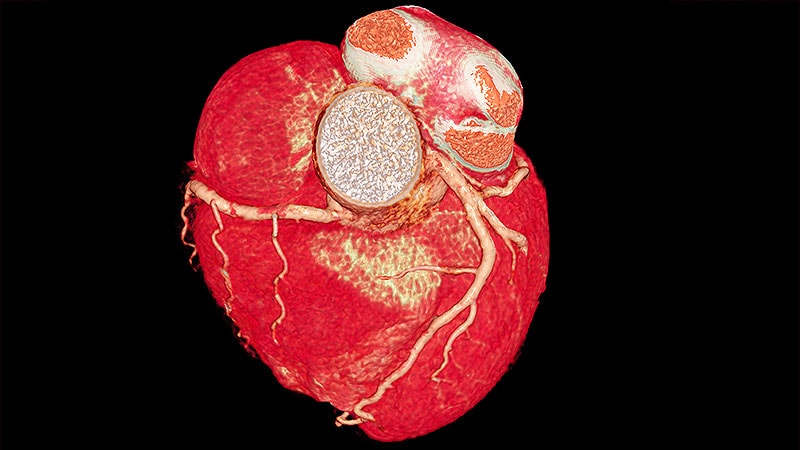TOPLINE:
An artificial intelligence (AI)-based assessment of coronary CT angiography outperformed visual assessment by human readers and demonstrated superior agreement with a quantitative coronary angiography reference standard for detecting stenosis in patients with coronary artery disease.
METHODOLOGY:
- Researchers performed a post hoc analysis of the PACIFIC-1 study, conducted between January 2012 and October 2014 in the Netherlands, to compare the accuracies of visual and AI-based assessments of coronary CT angiography.
- They included 208 patients (mean age, 58 years; 37% women; median total plaque volume, 218 mm3) with stable new-onset chest pain and suspected coronary artery disease who underwent coronary CT angiography.
- The visual assessment of the angiography was performed by a level 3 reader (a radiologist with > 5 years of work experience) and two level 2 readers (cardiologists in training).
- The AI-based assessment was performed using a proprietary atherosclerosis imaging quantitative CT (AI-QCT) software.
- The diagnostic accuracies of both the assessments were compared using an area under the curve (AUC) analysis at per-patient and per-vessel levels, with invasive quantitative coronary angiography as the reference standard.
TAKEAWAY:
- The AI-based assessment of coronary CT angiography at a per-patient level demonstrated superior performance in detecting ≥ 50% stenosis than visual assessments by both a level 3 (AUC, 0.91 vs 0.77) and level 2 readers (AUC, 0.91 vs 0.79 for reader 1 and 0.91 vs 0.76 for reader 2).
- The superior performance of the AI-based assessment was particularly notable in patients with plaque volumes above the median, outperforming the level 3 reader (AUC, 0.88 vs 0.77; P = .015) and both level 2 readers (AUC, 0.88 vs 0.72 for both; P = .007 and P = .004, respectively).
- Detection of ≥ 50% stenosis at the per-vessel level using the AI-based assessment was comparable with visual assessments by the level 3 reader but superior to visual assessments by the level 2 readers (AUC, 0.69; both P
- Concordance with the reference standard was significantly superior in the AI-based assessment than in visual assessments by level 3 or level 2 readers.
IN PRACTICE:
“Implementing AI-QCT in routine clinical practice may improve reproducibility and reliability of CCTA [coronary CT angiography] assessment, limiting the need for excess downstream testing while improving physician confidence,” the authors wrote.
SOURCE:
This study was led by Rachel Bernardo, the George Washington University School of Medicine and Health Sciences, Washington, DC, and Nick S. Nurmohamed, Amsterdam University Medical Center, Vrije Universiteit Amsterdam, Amsterdam, the Netherlands. It was published online on January 11, 2025, in Open Heart.
LIMITATIONS:
This study was conducted at a single center with a relatively small sample size. Some coronary vessels were not assessed for the presence of stenosis by the clinical readers due to motion or artifacts. The scores of segment involvement and stenosis were not available. Moreover, the clinical impact on treatment selection or downstream testing of the respective interpretations was not addressed.
DISCLOSURES:
This study was supported by the European Atherosclerosis Society and Heart Foundation and used AI-QCT software service from Cleerly (Denver, Colorado). Three authors reported receiving grants, and one author reported receiving speaker fees from foundations, pharmaceutical companies, and other sources including Cleerly. One author reported being a co-founder of Lipid Tools, and two authors reported being employees of Cleerly.
This article was created using several editorial tools, including AI, as part of the process. Human editors reviewed this content before publication.
Source link : https://www.medscape.com/viewarticle/ai-outperforms-human-readers-coronary-ct-angiography-2025a10001gn?src=rss
Author :
Publish date : 2025-01-22 09:34:41
Copyright for syndicated content belongs to the linked Source.
